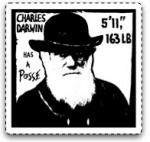
Three journals — Science, The Lancet, and National Geographic — are celebrating the bicentennial of the birth of Charles Darwin and the sesquicentennial of the publication of On the Origin of Species. They join Nature, which recently released "15 Evolutionary Gems" (PDF), a new resource summarizing fifteen lines of evidence for evolution by natural selection, and Scientific American, which took "The Evolution of Evolution: How Darwin's Theory Survives, Thrives and Reshapes the World" as the theme of its January 2009 issue — including NCSE's Glenn Branch and Eugenie C. Scott's discussion of the newest mutations of the antievolutionist movement in "The Latest Face of Creationism." And NCSE looks forward to a host of further journals joining the celebration!
Science is allocating a special section of its website to "celebrating the 150th anniversary of the publication of Charles Darwin's On the Origin of Species and the 200th anniversary of the author's birth with a variety of news features, scientific reviews and other special content, all collected here." Also Included are a new blog, Origins, and a monthly series of essays tackling major evolutionary questions, with January's essay, by Carl Zimmer, addressing the origin of life. Science editorially explains, "In marking his bicentenary, we reaffirm the values and practice of science, and the generous spirit of inquiry, observation, experiment, and discussion that Darwin himself exemplified. These values, and their fruits, need continued public promulgation. ... This year's bicentennial celebrations will only be a success if they meet this challenge."
A special issue of The Lancet for December 2008, entitled Darwin's Gifts, was "dedicated to Darwin's life and work and the enduring legacy of his theory of evolution" and is now freely available in a special Flash-based format. Among the topics discussed are Darwinism's fantastic voyage, The Origin of Species, Art and evolution, Evolution: medicine's most basic science, The evolution of fruit-fly biology, Socioeconomic inequalities in ageing and health, Forebears and heirs: a sketch, Synthetic biology, Darwin's charm, Bold flights of a speculative mind, Race, genetics, and medicine at a crossroads, Epigenetics in evolution and disease, Antibiotic resistance: adaptive evolution, and 21st century eugenics? The foreword is by Steve Jones, who argues, "Darwinism is the grammar of biology and should have the same role in medicine."
And Darwin is also the theme for the February 2009 issue of National Geographic. In "Darwin's First Clues," David Quammen explains, "Darwin's first real clue toward evolution came not in the Galápagos but three years before, on a blustery beach along the north coast of Argentina. And it didn't take the form of a bird's beak. It wasn't even a living creature. It was a trove of fossils. Never mind the notion of Darwin's finches. For a fresh view of the Beagle voyage, start with Darwin's armadillos and giant sloths." And in "Modern Darwins," Matt Ridley reviews how Darwin's insights have been refined, expanded, and deepened by scientists in the 150 years after the publication of the Origin. National Geographic's website also contains a video of Quammen discussing his article and even a Darwin trivia quiz.
